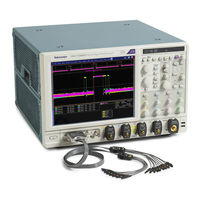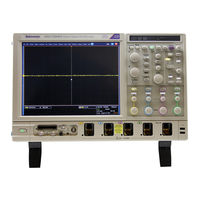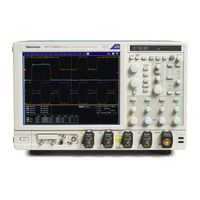Tektronix MSO5104B Signal Oscilloscope Manuals
Manuals and User Guides for Tektronix MSO5104B Signal Oscilloscope. We have 4 Tektronix MSO5104B Signal Oscilloscope manuals available for free PDF download: Printable Help, User Manual, Instructions Manual
Tektronix MSO5104B Printable Help (920 pages)
Digital Phosphor Oscilloscopes DPO70000SX Series; MSO70000DX Series; DPO70000DX Series; MSO70000C Series; DPO70000C Series; DPO7000C Series; MSO5000B Series; DPO5000B Series
Brand: Tektronix
|
Category: Test Equipment
|
Size: 33.68 MB
Table of Contents
-
Introduction31
-
-
-
-
Touch Screen105
-
Trigger Controls108
-
Trigger Coupling110
-
Run Controls110
-
-
Cursor Setups
117-
Track Mode118
-
Cursor Style121
-
Waveform Cursors124
-
Screen Cursors125
-
Digital Setups
131 -
Bus Setups
139-
Label a Bus143
-
View Bus Packet190
-
Magnivu Setup
195-
Using Magnivu195
-
-
Display Setups
199-
XY Format Pairs206
-
Remote Operation211
-
-
Autoset219
-
Undo an Autoset221
-
Enable Roll Mode225
-
Set up Zoom232
-
Linktraining
243 -
-
Mask Setup249
-
Tolerance Setup258
-
Fail Setup259
-
User Mask Setup268
-
Limit Test272
-
-
Math Setups
277-
-
FFT Process287
-
The FFT Display288
-
FFT Windows289
-
Aliasing291
-
-
-
Control Marks329
-
View Mark Counts344
-
-
Myscope Setups
403 -
Trigger Setups
409-
Set to 50415
-
A Event Triggers415
-
B Event Trigger491
-
-
Visual Trigger492
-
Define an Area499
-
Select a Channel503
-
-
Mode and Holdoff506
-
Vertical Setups
511-
Probe Properties542
-
-
Copy Setup549
-
Printing555
-
-
File Menu
559-
Action on Event566
-
Print Setups568
-
Saving568
-
Utilities
579-
Tek Secure Erase579
-
Touch Screen584
-
-
-
Set up a Bus613
-
-
Analyzing Buses618
-
-
How to ?
607-
Using Waveforms648
-
Save a Waveform648
-
-
-
Using Roll Mode651
-
Set up Roll Mode651
-
Using Roll Mode652
-
-
Triggering652
-
Pattern Triggers661
-
Trigger on a Bus668
-
Using Histograms671
Advertisement
Tektronix MSO5104B User Manual (222 pages)
MSO70000C/DX Series; DPO70000C/DX Series; DPO7000C Series; MSO5000B Series; DPO5000B Series Mixed Signal Oscilloscopes; Digital Phosphor Oscilloscopes
Brand: Tektronix
|
Category: Test Equipment
|
Size: 19.33 MB
Table of Contents
-
Preface20
-
-
Acquisition53
-
-
-
-
Myscope168
Tektronix MSO5104B User Manual (222 pages)
Brand: Tektronix
|
Category: Test Equipment
|
Size: 5.04 MB
Table of Contents
-
Preface20
-
Key Features20
-
Front Panel39
-
Acquisition53
-
Myscope168
Advertisement
Tektronix MSO5104B Instructions Manual (26 pages)
Mixed Signal Oscilloscopes, Digital Serial Analyzers, Digital Phosphor Oscilloscopes, Digital Phosphor Oscilloscopes Declassification and Security
Brand: Tektronix
|
Category: Analytical Instruments
|
Size: 0.34 MB
Table of Contents
-
Preface5
-
Products5
-
Terms6
-
Change Log26



